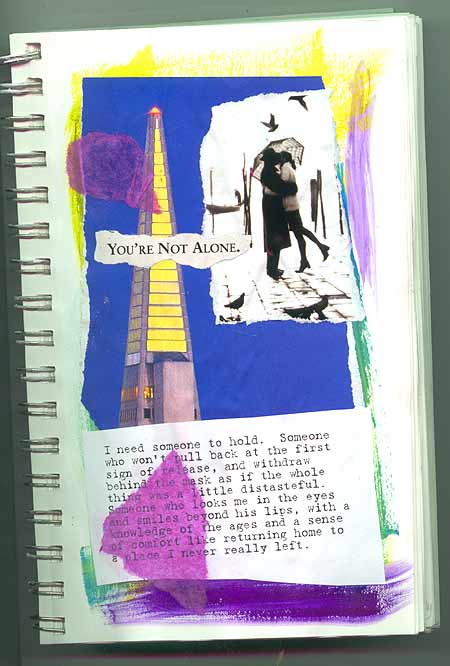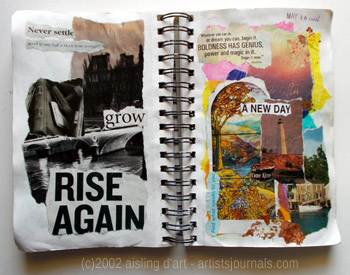 Wax paper is always among my basic journaling supplies, and I use it any time I need to protect pages that include glue, water media, or anything sticky.
Wax paper is always among my basic journaling supplies, and I use it any time I need to protect pages that include glue, water media, or anything sticky.
When I travel, I pre-cut sheets of wax paper, and tuck them into the back of my journal. Usually, I use a rubber band or a binder clip to hold them in place, so I don’t lose the sheets.
The following article is based on one that I wrote around 2005, and it’s still important for many people creating artists journals.
Wax paper can be a vital tool if you’re keeping an art journal. Wax paper can separate damp art journal pages — after they’ve been painted or collaged — so they don’t stick together. I carry wax paper with me when I travel, so I can work on several journal pages in a row, and not wait for pages to dry completely.
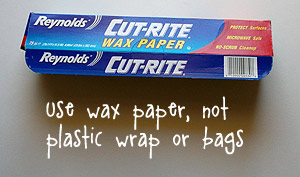 Wax paper has many great features:
Wax paper has many great features:
- Wax paper is inexpensive.
- It’s slightly porous (so the pages dry underneath). In other words, the air can get through.
- It’s super-easy to use.
- Wax paper is environmentally friendly.
- You can often use the same sheet two or three times before throwing it away.
You’ll find wax paper at the grocery store, in the aisle with foil and plastic (cling) wrap. In the States, the leading brand is Reynolds’ Cut-Rite wax paper. That’s it in the photo. The package is about the same size as a roll of foil or plastic (cling) wrap.
Sometimes it’s half-hidden on the bottom shelf. In other areas, wax paper is a popular product for use with microwave ovens, so you’ll find wax paper more prominently displayed.
Regular wax paper is generally not recyclable. The wax surface (often made with petroleum products) is considered a “mixed” paper product. I have not yet tried any of the recyclable wax papers (like “If You Care” brand wax paper) with my artists journals.
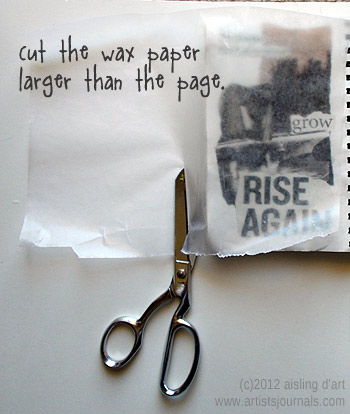 When I’m separating journal pages with wax paper, I try to let each page dry so it’s only damp, not wet. (Sometimes I have no choice. If the page is really sticky and I can’t wait for it to dry at all, I have to hope for the best.)
When I’m separating journal pages with wax paper, I try to let each page dry so it’s only damp, not wet. (Sometimes I have no choice. If the page is really sticky and I can’t wait for it to dry at all, I have to hope for the best.)
Then, I place the journal so the pages are as flat as possible.
After that, I cut or tear the wax paper so each piece is slightly larger than the journal page it will protect. An extra half-inch on each side is usually enough.
The key to success is not to allow much weight or pressure on damp pages. In other words, the wax paper should practically float on the damp page. Don’t press it onto the page.
WAX PAPER AND GESSO
Generally, I gesso five or six pages at a time. I’ve successfully gesso’d up to eight pages at a time. However, I’m usually working with spiral-bound sketchbooks. They’re generally my favorite journals.
If I was working with a regular, bound journal, I’d watch carefully to see how much the binding “pulls” the pages back together. I might have to work with just two pages at a time.
(Big binder clips can come in handy if the binding on the journal is really tight. Clip the dry pages together — in separate bunches, if necessary — and that should take some of the pressure off binding, keeping the damp pages apart.)
Remember, wax paper is not 100% reliable when you want to keep wet pages apart. If your journal page is the most perfect thing you’ve ever created, and you’d be devastated if it was damaged… well, stop journaling until that page has dried completely.
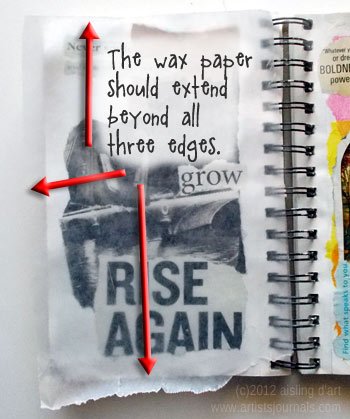 From my experience, wax paper sticks about 10 – 15% of the time. I may collage over those pages later, since the surface of the page is already a bit distressed. Or, I may leave them “as-is” to reflect the creative process.
From my experience, wax paper sticks about 10 – 15% of the time. I may collage over those pages later, since the surface of the page is already a bit distressed. Or, I may leave them “as-is” to reflect the creative process.
It all depends upon how they look when the page is dry, and I take a fresh look at it.
I’ve used wax paper when I’ve gesso’d in airplanes (very dry air) and — at the other extreme — in sultry, humid Houston.
I have slightly better success with wax paper when the air is dry and the pages dry more quickly.
If you try wax paper and don’t have much success with it, try gently crushing the wax paper — before you use it — so it holds the pages slightly apart.
Note: It’s important to gently crush the wax paper; if you fold it enough that the wax falls off at the crease, that line (or point) may stick to wet paint, gel medium, or gesso.
WAX PAPER AND PAINT
When I want to separate wet, painted journal pages, I’m far more careful with the pages.
Then, I will separate two pages at the most: The one that I’ve just painted, and the one that I’m currently working on. Because wax paper isn’t 100% non-stick, I don’t want to risk damage.
Remember: Less weight or pressure on the wax paper means less risk of sticking. Also, the drier the pages, the better.
Paint is designed to be sticky and adhere to paper. If it’s so wet that the moisture actually penetrates the wax paper, the results may be disappointing.
Weigh your options carefully. If your painted journal page is the best thing you’ve ever created, maybe it’s more important to preserve that, as-is, than rush into the next journal page. (If you’re in a class and this happens, have a second or third journal with you. Then, you can keep working while the first journal page dries, and not miss any valuable class time.)
WAX PAPER AND GEL MEDIUM OR GLUE
Wax paper is best for separating pages with small amounts of wet gel medium or glue on them. However, most gel medium won’t stick to wax paper.
In storage, I also use wax paper to protect every page of my collaged art journals. Then, even during sultry summer heat, the gel medium doesn’t re-soften and stick to the page opposite it.
Think of it this way: We use an iron to “melt” gel medium for image transfers. Likewise, gel medium can become sticky if you store your journals in a hot attic, garage, or other really warm area.
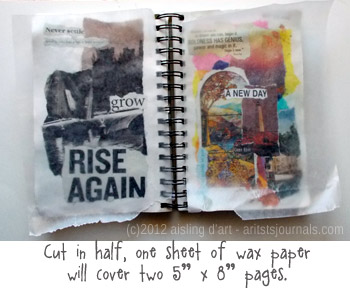 Unlike gel medium, glue can be hit-or-miss with wax paper. It can vary with how wet the glue is, and if the glue contains alcohol or any kind of solvent. (Alcohol and solvents will dissolve the wax on the wax paper, so it’s useless.)
Unlike gel medium, glue can be hit-or-miss with wax paper. It can vary with how wet the glue is, and if the glue contains alcohol or any kind of solvent. (Alcohol and solvents will dissolve the wax on the wax paper, so it’s useless.)
You can test this ahead of time. Put a blob of the glue on a piece of paper, and place a piece of wax paper on top of it. Press gently, enough so contact occurs.
Then, wait a minute or two and see if the wax paper sticks to the glue. If it does, wax paper won’t protect your journal pages where that glue is wet and exposed.
You may be safe with sheets of foil as separators. Or, consider thin sheets of teflon-coated plastic, sold in kitchen supply shops; they were invented to safeguard very sticky cookies, meringues, and so on.
Plastic wrap (cling film) isn’t usually helpful. It tends to stick to paint, gel medium and glue, and some glues will completely melt it. If you have to choose between plastic wrap and nothing between the damp pages, opt for nothing. Really. Some plastic wraps — especially the more expensive kinds — are practically guaranteed to stick to your damp pages, prevent them from drying (ever), and not peel off (ever).
SUMMARY
Wax paper is a valuable tool when you’re working with damp pages in your art journal or illustrated diary.
Wax paper isn’t foolproof, but it’s still one of the best and least expensive ways to keep damp pages from sticking to each other.
You’ll have the best luck when you’re working with gel medium. Gesso and glue have a higher “failure” rate with wax paper.
However, in art there are no “failures,” just challenges and opportunities to create new and different art, and to make the most of life’s surprises.
The good news is, wax paper will prevent most damp pages from sticking together. And, for most of my own journaling, that’s good enough.

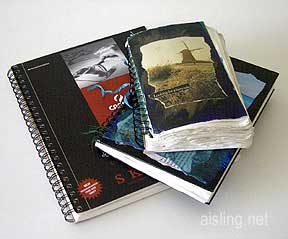 Gesso can be a useful for art journaling as well as painting and mixed media art.
Gesso can be a useful for art journaling as well as painting and mixed media art.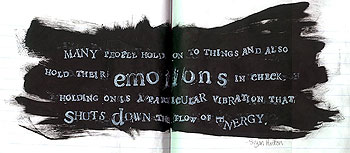
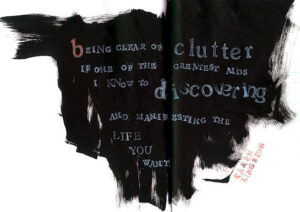


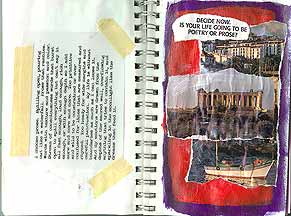
 Then I’ll have the one at hand. Right now, with maybe ten more pages left in it, it’s my “Hogwarts Journal.” (That’s it in the photo, at left.) It’s a journal that started as a place to jot notes & sketches for the university I’d love to create someday, either on my own or with my friends.
Then I’ll have the one at hand. Right now, with maybe ten more pages left in it, it’s my “Hogwarts Journal.” (That’s it in the photo, at left.) It’s a journal that started as a place to jot notes & sketches for the university I’d love to create someday, either on my own or with my friends.